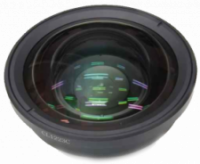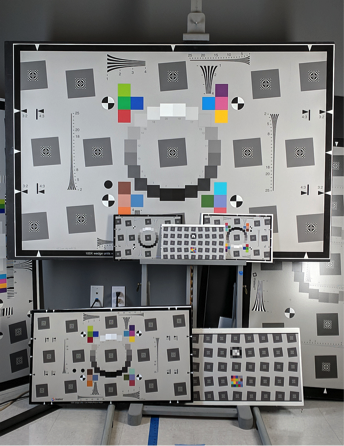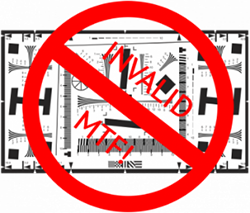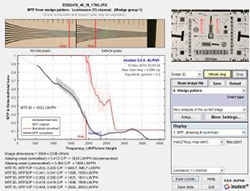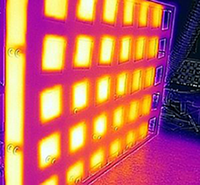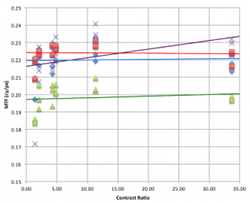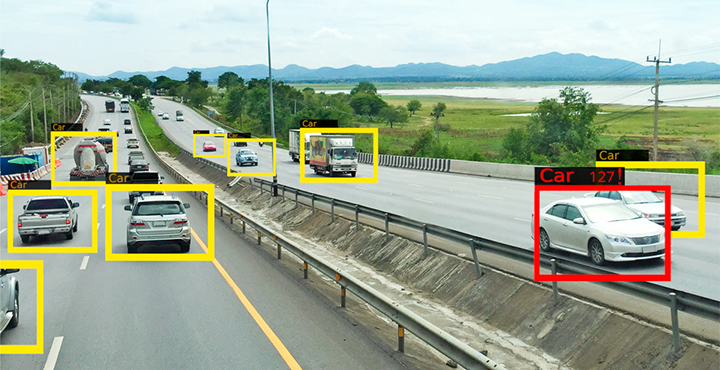Search Results for: MTF
Understanding collimator MTF loss using bronze and golden sample testing
by Henry Koren, inspired by Paul Romanczyk, edited by Norman Koren Not all MTF measurement systems will necessarily provide the same results. The quality of the test target can impact the measurements you obtain. Long distance tests are ideally performed at the hyperfocal distance, where there is enough depth of field to have acceptable focus at infinity.
Compensating MTF Measurements for Chart Quality Limitations
Camera MTF (sharpness) measurements are subject to a number of variations, some of which, like noise, are random and difficult to control, and some of which are systematic and can be corrected. Variations caused by limitations in chart sharpness are in the latter category. These variations are also affected by the Field of View (FoV) of the image used to test the camera, which is closely related to chart size for charts designed to fill the camera frame. For a given print technology, increasing the FoV, which typically means increasing the spacing between the chart and camera, will increase the […]
Correcting nonuniformity in slanted-edge MTF measurements
Slanted-edge regions can often have non-uniformity across them. This could be caused by uneven illumination, lens falloff, and photoresponse nonuniformity (PRNU) of the sensor. Uncorrected nonuniformity in a slanted-edge region of interest can lead to an irregularity in MTF at low spatial frequencies. This disrupts the low-frequency reference which used to normalize the MTF curve. If the direction of the nonuniformity goes against the slanted edge transition from light to dark, MTF increases. If the nonuniformity goes in the same direction as the transition from light to dark, MTF decreases. To demonstrate this effect, we start with a simulated uniform slanted […]
High-contrast edge-SFR test targets produce invalid MTF results
The obsolete ISO 12233:2000 standard defines a resolution test target with a high contrast ratio. These are typically produced at the maximum dynamic range of a printer, which can be anywhere from 40:1 to 80:1. The high contrast can lead to clipping of the signal which leads to overstated invalid MTF values.
Gamma, Chart Contrast and MTF Calculations
A fuller and more up-to-date explanation of gamma, including how to obtain it for slanted-edge MTF calculations can be found on Gamma, Tonal Response Curve, and related concepts. Gamma (the average slope of log pixel levels as a function of log exposure for light through dark gray tones) is used, per the ISO 12233 standard, to linearize the input data, i.e., to remove the gamma encoding applied by the camera or RAW converter. Gamma defaults to 0.5 = 1/2, which is typical of digital cameras, but may be affected by camera or RAW converter settings. Imatest Settings For accurate calculation of edge-SFR from using […]
Infrared Targets, Correction for Slanted-Edge MTF Measurements
Infrared Targets Standard Imatest inkjet-printed test charts produced prior to February 2016 work in Near InfraRed (NIR) wavelengths out to approximately 1 micron. In February 2016 we upgraded our printers and found (to our disappointment) that our new printers do not have the same reflective densities for NIR wavelengths as for visible wavelengths. We are working out solutions to this issue. Please contact us if your needs include NIR.
Measuring Multiburst pattern MTF with Stepchart
Measuring MTF is not a typical application for Stepchart— certainly not its primary function— but it can be useful with multiburst patterns, which are a legacy from analog imaging that occasionally appear in the digital world. The multiburst pattern is not one of Imatest’s preferred methods for measuring MTF: see the MTF Measurement Matrix for a concise list. But sometimes customers need to analyze them. This feature is available starting with Imatest 4.1.3 (March 2015).
LSF correction factor for slanted-edge MTF measurements
A correction factor for the slanted-edge MTF (Edge SFR; E-SFR) calculations in SFR, SFRplus, eSFR ISO, SFRreg, and Checkerboard was added to Imatest in 2015. This correction factor is included in the ISO 12233:2014 and 2017 standards, but is not in the older ISO 12233:2000 standard. Because it corrects for an MTF loss caused by the numerical calculation of the Line Spread Function (LSF) from the Edge Spread Function (ESF), we call it the LSF correction factor.
Validating Information Metrics Correlation with Object Detection
We are in the age of Artificial Intelligence that depends on machine vision. This technology surge has necessitated thinking about camera systems in new ways because machine vision systems based on neural networks have different requirements from camera systems intended for human perception. Norman Koren, Imatest’s founder, has developed a novel approach for evaluating the quality of machine vision systems based on information theory, which is widely used in electronic communications. The image signal and noise (or SNR) are entered into the Shannon-Hartley equation to calculate Information capacity, which is the maximum amount of information that can pass through a […]
Simatest – Camera/ISP Simulator – Overview
Simatest Overview — focusing on what you can do with Simatest Details on how to use Simatest are in the links below. Related web pages Simatest ISP/Camera Simulator — Instructions and Reference – Very detailed Simatest examples – Examples of how Simatest can be used. Compares simulations to measurement. Image Sensor Noise – measurement and modeling – using raw files for image sensor Dynamic Range and Simatest Using Color/Tone Interactive – Interactive analysis of color & grayscale test charts Color/Tone & eSFR ISO noise measurements – describes how to measure image sensor noise from raw images Image information metrics – new measurements, based […]


